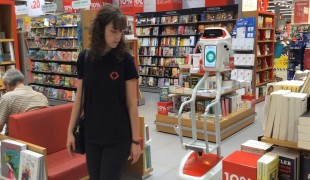- 12109
- 644
- 16
- 21
- 0
- Help Ukraine
About the solution
They founded (these)abilities, a design & technology startup that aims to "Disable Disabilities" by designing & building products that level the playing field for Persons with Disabilities (PwDs) at work, at home and during play.
A keyguard is a plastic or metal plate placed on top of a keyboard, with holes aligned to the keyboard's keys.
It makes the keys recessed, making it easier for people with upper-limb mobility issues - such as those who have suffered strokes or have Parkinson's disease or muscular dystrophy - to use a keyboard.
They changed the manufacturing process by using a new technology in which the scanned image of a keyboard layout can be sent to a laser cutting facility to cut the plastic according to the layout. This means keyguards can be customised to any keyboard, and costs are halved.
"I felt it was social injustice. People are born differently abled, not disabled, but because society has minimal inclusion for such people, it renders them disabled. I found it to be a design problem," he said.
(these)abilities was recently selected for a programme which helps start-ups that tackle challenges faced by people with disabilities, and it received seed funding of $10,000 from Singtel earlier this year. Singtel's vice-president of group corporate social responsibility Andrew Buay said: "Their business model focused on simple and cost-effective accessibility solutions for persons with disabilities."
Adapted from: http://bit.ly/1Y0D7gs
More info: http://www.theseabilities.com/
What about you, do you have any solutions? Please share them with the Patient Innovation community!
This solution shall not include mention to the use of drugs, chemicals or biologicals (including food); invasive devices; offensive, commercial or inherently dangerous content. This solution was not medically validated. Proceed with caution! If you have any doubts, please consult with a health professional.
DISCLAIMER: This story was written by someone who is not the author of the solution, therefore please be advised that, although it was written with the utmost respect for the innovation and the innovator, there can be some incorrect statements. If you find any errors please contact the patient Innovation team via info@patient-innovation.com
-
-
241
-
0
-
2653

Collaborator James Leckey makes equipment to improve the quality of life and social inclusion of children with special needs
MOVING IN A WHEELCHAIR: Moving using a wheelchair.
BODY BALANCE: Maintaining body balance
STANDING UP: Standing up from a seated position
Playing
Neuromuscular Disorders
Assistive Daily Life Device (to help ADL)
Walking Aid (wheelchair/walker/crutches)
Assistive Technology access
5 Senses support devices: (glasses, hearing aids, headphones...)
Restoring mobility
Promoting self-management
Managing Neurological Disorders
Promoting inclusivity and social integration
Maintaining Balance and Mobility
Raise awareness
General and Family Medicine
Neurology
Orthopedics
Pediatrics
Physical Medicine and Rehabilitation
United States
-
-
-
619
-
0
-
9193

Wheelchair user invents robotic shopping cart
MOVING IN A WHEELCHAIR: Moving using a wheelchair.
Shopping
Cerebral Palsy
Neuromuscular Disorders
Paralysis
Spinal Cord and Nerve Root Disorders
Cervical spinal cord injury/Tetraplegia
3d Printed
Assistive Daily Life Device (to help ADL)
Assistive Technology access
Muscle cramps or spasms
Difficulty coordinating movements
Stiffness or rigidity (difficulty moving)
Paralysis of the legs and lower body
Muscle weakness
Promoting self-management
Managing Neurological Disorders
Promoting inclusivity and social integration
General and Family Medicine
Neurology
Orthopedics
Portugal
-
-
-
674
-
0
-
12189

Helmet with multifunction tip
Video gaming
Writing (letters, songs, peoms)
Cerebral Palsy
Assistive Technology access
Body-Worn solutions (Clothing, accessories, shoes, sensors...)
Tremors
Muscle cramps or spasms
Stiffness or rigidity (difficulty moving)
Muscle weakness
Trouble with fine motor skills (e.g., writing, buttoning clothes)
Promoting self-management
Managing Neurological Disorders
Promoting inclusivity and social integration
Caregiving Support
Neurology
Pediatrics
Portugal
-
 en
en